Will Pfeifer's Blog, page 24
September 5, 2014
Movies I saw in August
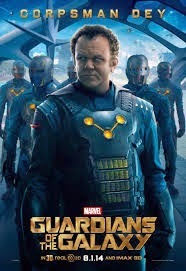
Yes, in case you were wondering, it’s as much fun as everyone says it is, with the same sort of ragged, low-key charm that kept audiences coming back to the original “Star Wars” again and again. Favorite bits? (Spoilers, of course) I really liked the quiet moment when Drax comforted Rocket after the (again, spoilers) death of Groot, and speaking of which, that “We are Groot” moment is the sort of semi-silly, semi-poignant connection you hope for in a movie like this. I also like the prison escape near the beginning, which kept a lot of parts moving without over-explaining to the audience what the heck was happening, trusting us to figure it out on our own. It’s just a fun, sweetheart of a movie, the sort of thing that’s going to be fondly remembered for years to come. I don’t think it was the best movie of the year so far, but I do love the fact that’s the biggest money maker. And yes, I've already pre-ordered Allie (who also loved the film) a Dancing Baby Groot.

I got the Blu-ray for my birthday and couldn’t wait to check it out again. (It’s so packed with detail it pretty much demands more than one viewing.) Definitely one of the best movies of 2014, and I’d say one of the Wes Anderson’s best movies period. I wrote more about it here, but allow me to add that if any movie benefits from the crispy hi-def image of a Blu-ray player, it’s this intricately constructed comic masterpiece.
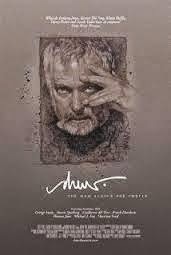
Amy and I have been dipping into some of the many, many documentaries on Netflix, and this one, "Drew: The Man Behind the Poster," about legendary movie poster artist Drew Struzan, was just the sort of low-key offering we were looking for. Struzan is the guy who painted such classic movie posters as “Raiders of the Lost Ark,” “Back to the Future” and, ahem, the “Police Academy” films, so you see plenty of gorgeous artwork during the doc. (Even his posters for less-than-classic movies are beautiful works of art.) But you also get to know the man himself, an artist who left a less-than-loving home (Struzen is surprisingly matter-of-fact about his relationship with his parents) to first find success creating album covers before moving onto the (much) more lucrative world of movie posters. And, given his resume, you hear from some of the people he’s worked with or depicted, including Steven Spielberg, Frank Darabont, Michael J. Fox, Guillermo Del Toro, George Lucas and Harrison Ford. (As the movie slyly points out, your image of Harrison Ford probably owes a lot to Struzen’s artwork.) The doc does lament the current sorry, Photoshop-reliant state of movie poster art, but thankfully, it’s mostly a salute to one of the all-time great practitioners of the form.
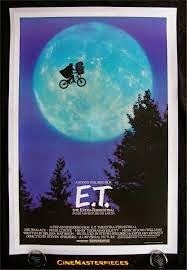
Allie had never seen this Spielberg classic, which once, let’s all remember, was the biggest movie in the entire world, back in the days when that actually meant something. (Unless I’m wrong, and I could be, it took that title from “Star Wars” and held onto it until, what? “Jurassic Park”? Is that possible? ) Anyway, though Allie grumbled through most of it (I think she wanted to watch episodes of “Wild Kratts” for the nine-billionth time instead), by the last chunk of “E.T.,” she was completely into it and afterwards admitted it was pretty good. Me? Well, I hadn’t seen it since I saw it in theater, way back in 1982, and I have to say, I was both surprised and impressed. These days, if it’s mentioned at all, “E.T.” is held up as a classic example of shamelessly manipulative Spielberg corn, but it’s actually a lot darker and stranger than that. This is still early Spielberg, and "E.T." feels a lot like a classic 1970s movie, with shadowy images and a real sense of down-to-earth family life and well-earned government paranoia. One thing I noticed this time around is that, aside from the mom played by Dee Wallace, there are absolutely no faces of adults visible until the last act of the movie when (spoilers) the government agents take over the house and there are medical crews everywhere. And yes, it’s still a heart-tugger, playing audiences like a Stradivarius as E.T. (again, spoilers) dies, is born again and goes back to his home in the sky (a lot like another famous visitor to Earth, eh?). But it works, dammit, it works, and though I wasn’t blubbering like my normally cynical wife Amy was, I did get a little choked up when you catch a glimpse of E.T.’s heart re-lighting up as they seal him in his high-tech coffin. When I was a kid, I of course identified with Elliot, but this time around I really liked Peter Coyote’s character. You don’t see his face until almost the end of the movie, but there’s something really effective about the way Spielberg reveals that instead of a government bad guy, he’s really just Elliot, all grown up. By the way, despite what you might have read on the internet, that is not Harrison Ford as the science teacher. However, that is “Baywatch” babe Erika Eleniak as the girl Elliot smooches.
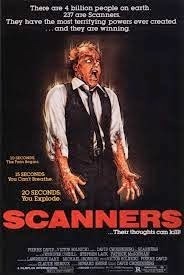
With Amy and Allie at the in-laws for a couple of nights, I decided to watch a couple movies I knew they wouldn’t be sitting through (especially, of course, Allie). Criterion just released this new Blu-ray of David Cronenberg’s notorious 1981 thriller “Scanners,” so that went into the player first. Though I’m a huge fan of Cronenberg and like a lot of things about “Scanners” (specifically the chilly, unnerving look of the thing), I have to admit that on the whole, it’s not one of his best and doesn’t come close to the creepy brilliance of “Videodrome,” “The Fly” or “The Brood” (or even, for that matter, “Shivers.”) Sure, the exploding head at the opening lives up to its rep, but the rest of the movie can’t compete, with a meandering plot and a lead performance by Stephen Lack that lacks (sorry) any sort of charisma. Thank god for crazy ol’ Michael Ironside, who gives “Scanners” a much needed jolt of energy every time he’s onscreen.
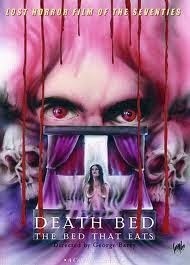
This is what went into the player after “Scanners,” and maybe it was lowered expectations (in all the reviews I’ve tracked down, no one says this 1977 obscurity is actually, you know, good) or maybe it was the relatively late hour (this is a movie that definitely plays better late at night, and not just because the word “bed” is in the title – twice), but I liked it. A lot. A lot more than “Scanners,” in fact. Patton Oswalt has a well known stand-up routine mocking the movie, but though it's definitely goofy, it's also imaginative and downright hypnotic if you're in the right frame of mind. The plot? A bed in the basement of a crumbling estate has been possessed by a demon and swallows (devours? absorbs?) all those foolish enough to lie on it. It's a silly premise, but that description barely scratches the surface of how gloriously weird this movie is. Besides the parade of frequently naked visitors (it was the '70s, after all), "Death Bed" features endless images of body parts and other foreign objects slowly sinking through the yellow liquid that's apparently inside the bed. Plus, as a bonus, there's an artist (who narrates the movie) trapped behind a painting in the room, somehow spiritually condemned to watch the bed eat everyone. The craziest part? He's played by famous rock critic Dave Marsh! Ah, the '70s!
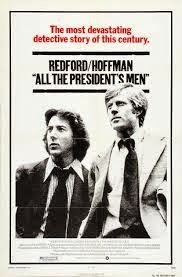
I’m reading Rick Pearlstein’s new history of the 1970s, “The Invisible Bridge,” and after enjoying the chapters where he details the Watergate scandal and the fall of Nixon in delicious detail, I decided to give this old favorite another spin. It’s such a great movie – serious and complex but endlessly entertaining, with an ominous mood that never really lets up from its first scene (burglars caught) to its last (teletype announces Nixon’s resignation). Everything comes together: Alan Pakula’s tension-filled direction, William Goldman’s smart script, Gordon Willis’ spooky cinematography and the top-notch cast, with Redford and Hoffman given amazing support by old pros like Martin Balsam, Jack Warden and, of course, Jason Robards as Ben Bradlee. One of my all-time favorites.
Published on September 05, 2014 15:51
August 28, 2014
Movies I'm looking forward to in the fall of 2014: 'Birdman'
I think we can all agree that fall is the finest time of year, and it has little to do with falling leaves or carven pumpkins. Mostly it's because the summer movie season is over and studios get serious about pandering for Oscars, which means they release the most potentially interesting movies of the year.
This year, that doesn't quite apply because, let's face it, it's already been a pretty good year for movies and the first leaf hasn't even hit the ground yet. Personally, I've already seen "Edge of Tomorrow," "The Grand Budapest Hotel," "Captain Amercia: The Winter Soldier," "The Lego Movie," "Guardians of the Galaxy" and "Snowpiercer," and though none of them would be considered awards bait (except maybe "Budapest,") I have little doubt they'll wind up being among the best movies of this year -- and a few of them would rank as the best movie in most years (including "Budapest).
But that doesn't mean there's nothing promising on the horizon. For instance...
"Birdman"I've written about this movie before, but the buzz has gotten even louder since then. "Birdman" had a press screening in Venice, and the reaction has been pretty damned stellar. Peter Debruge of Variety, for instance, called it “a triumph on every creative level, from casting to execution, that will electrify the industry, captivate arthouse and megaplex crowds alike, send awards pundits into orbit and give fresh wings to Keaton’s career." (Read more reaction here.) Sounds promising, right? Now check out this trailer...
... and tell me the idea of an actor who played a superhero trying to jump-start his career (and possibly save his life) with a Broadway show doesn't hold plenty of potential. Then figure in the fact that that actor is being played by the great Michael Keaton and step back and consider the potential genius of the entire project. (Imagine, for a moment, watching Keaton walk on the stage to accept his Oscar...) Sure, it could fall on its face (though I doubt it will), but even if it does fail, a movie with this much potential can't help but fail gloriously. Something like this, so out there and yet so potentially powerful, it's the reason I go see movies in the first place.
Next: Another period piece from PTA
This year, that doesn't quite apply because, let's face it, it's already been a pretty good year for movies and the first leaf hasn't even hit the ground yet. Personally, I've already seen "Edge of Tomorrow," "The Grand Budapest Hotel," "Captain Amercia: The Winter Soldier," "The Lego Movie," "Guardians of the Galaxy" and "Snowpiercer," and though none of them would be considered awards bait (except maybe "Budapest,") I have little doubt they'll wind up being among the best movies of this year -- and a few of them would rank as the best movie in most years (including "Budapest).
But that doesn't mean there's nothing promising on the horizon. For instance...
"Birdman"I've written about this movie before, but the buzz has gotten even louder since then. "Birdman" had a press screening in Venice, and the reaction has been pretty damned stellar. Peter Debruge of Variety, for instance, called it “a triumph on every creative level, from casting to execution, that will electrify the industry, captivate arthouse and megaplex crowds alike, send awards pundits into orbit and give fresh wings to Keaton’s career." (Read more reaction here.) Sounds promising, right? Now check out this trailer...
... and tell me the idea of an actor who played a superhero trying to jump-start his career (and possibly save his life) with a Broadway show doesn't hold plenty of potential. Then figure in the fact that that actor is being played by the great Michael Keaton and step back and consider the potential genius of the entire project. (Imagine, for a moment, watching Keaton walk on the stage to accept his Oscar...) Sure, it could fall on its face (though I doubt it will), but even if it does fail, a movie with this much potential can't help but fail gloriously. Something like this, so out there and yet so potentially powerful, it's the reason I go see movies in the first place.
Next: Another period piece from PTA
Published on August 28, 2014 19:00
August 20, 2014
Buy My Comics, Make Me Rich: TEEN TITANS #2
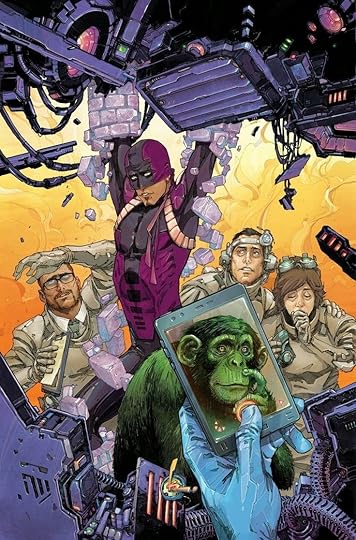
The second issue of TEEN TITANS hits the stands today, and as proud as I was of that inaugural ish, I can honestly say this one is an improvement. Now that all the heroes have been (re) introduced and the pieces are in place, we can start having some fun moving them around. As you might've guessed by the cover, the focus falls largely on Bunker and Beast Boy this issue, with artist extraordinaire Kenneth Rocafort really excelling when it comes to depicting the beasts that boy changes into. (Wait 'til you see the baby elephant). Plus, there's a mysterious scene with Red Robin, some brutal action inspired by Wonder Girl and a musical interlude with Raven. Check it out, won't you?
Want a special sneak preview? Click here.
Published on August 20, 2014 03:30
August 18, 2014
Same old movie, brand new title: Release, rename, repeat
So this movie...
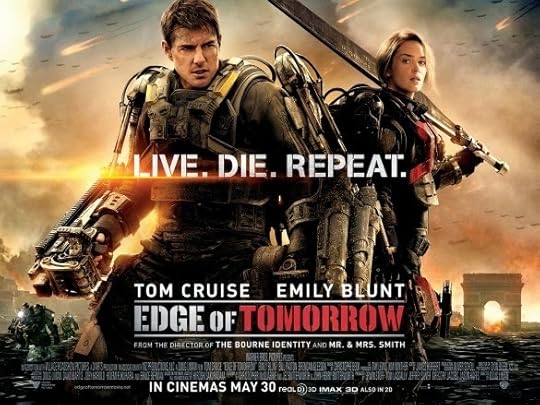
... which, despite being a very entertaining, imaginative science fiction/action film, the sort of thing you'd think would have all the elements (major movie star, clever script, huge budget, creepy aliens) of a sure-fire summer blockbuster, didn't exactly light up the box office as expected and, despite making back its initial (and considerable investment), was regarded as a disappointment, money wise. (Having seen it in the theater, I can assure you it was not a disappointment quality-wise.)
Many people, yours truly included, thought that the dull, by-the-numbers title "Edge of Tomorrow" couldn't have done much to draw people into the theater -- especially when the movie was based on a Japanese novel with a much more memorably oddball title...

Now, granted, maybe "All You Need Is Kill" is too grammatically weird to capture people's interest -- people in these United States, at least -- and there's always the possibility that, had the movie actually gone out with that title, it would've made even less money. But we'll never know, will we? Plus, as much as I like the sheer strangeness of "All You Need Is Kill," I have to admit it doesn't really tell you much more about what the movie is actually about than "Edge of Tomorrow" -- except, of course, for the fact that the plot involves killing. But, seeing Tom Cruise and Emily Blunt armored up and holding deadly weapons probably clued audiences into that specific fact.
Thankfully, for the video release, someone at Warner Bros. had the bright idea that the tagline on that original poster up top would be a much better title than the soap opera-worthy "Edge of Tomorrow," so when the film hits DVD and Blu-ray on Oct. 7, the three words in that tagline -- which manage to (a) be intriguing and (b) sum up the actual plot of the movie -- will be featured boldly on the package. So boldly, in fact, that the movie is, in effect, being retitled for home release...
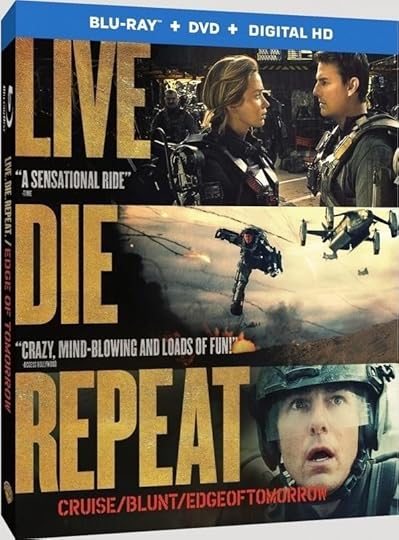
... with "Edge of Tomorrow" relegated to a small strip at the bottom after the names of the stars. So does this mean the movie has actually been given a new title? According to The Dissolve, the press release hyping the Blu-ray refers to the movie as "Edge of Tomorrow," and I'm guessing (though I'm not sure) that the actual movie itself will feature the old title onscreen. But hell, if "Live Die Repeat" gets more people to watch this movie -- which, I can't stress enough, is excellent -- then more power to the new title.
This sort of retitling isn't new, of course. No one in the world -- including George Lucas -- called "Star Wars" anything but "Star Wars" back in 1997, but somehow, with all the myriad sequels and prequels, it's become officially known as "Star Wars: Episode IV - A New Hope" -- and in that case, the wording has been changed onscreen (along with a lot of other original material, unfortunately.) And the movie once known as "Raiders of the Lost Ark" is now referred to "Indiana Jones and the Raiders of the Lost Ark," though I can't remember if that particular change has been reflected onscreen.
Every so often, a controversy will prompt a title change, like in 1999 when the shootings at Columbine resulted in the forgotten teen flick "Killing Mrs. Tingle" being renamed "Teaching Mrs. Tingle," though that was before the movie hit theaters. And 2012's "The Watch" was originally called "Neighborhood Watch" but rechristened by the time of its release to avoid being connected to the shooting of Trayvon Martin.
Back in the good ol' days of exploitation movies, films would be titled and retitled by exhibitors in hopes of luring the same audience into watching (and, more importantly, paying to see) the same movie multiple times. Back in January, I wrote about watching the 1956 potboiler "The Wild and Wicked" on Turner Classic Movies," not realizing that I already owned the film in a "cult classics" collection under its alternative title, "The Flesh Merchant." But my favorite example of that sort of creative retitling is what happened with the 1977 sleaze classic "Fight for Your Life"...
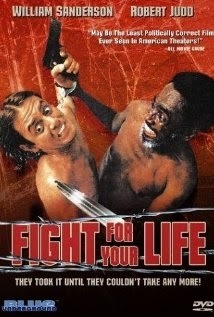
The film focuses on an extremely violent confrontation between a racist ex-con (William Sanderson, best remembered as Larry on "Newhart") and a black minister (Robert Judd). Packed with nasty violence and nastier language, it was released with the fairly generic title "Fight for Your Life." But it also went out to theaters in black neighborhoods with a different poster, a different trailer and a completely different title...
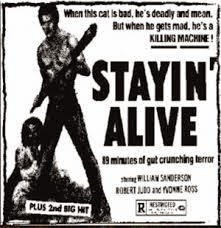
Dig the new rhyming tagline: "When this cat is bad, he's deadly and mean. But when he gets mad, he's a killing machine." Clearly, the producers realized that if they were going to try to sell a movie that's mostly a loudmouth racist abusing a black minister and his family (until the inevitable turning of the tables at the end), they were going to have to sell it differently. Very differently.

... which, despite being a very entertaining, imaginative science fiction/action film, the sort of thing you'd think would have all the elements (major movie star, clever script, huge budget, creepy aliens) of a sure-fire summer blockbuster, didn't exactly light up the box office as expected and, despite making back its initial (and considerable investment), was regarded as a disappointment, money wise. (Having seen it in the theater, I can assure you it was not a disappointment quality-wise.)
Many people, yours truly included, thought that the dull, by-the-numbers title "Edge of Tomorrow" couldn't have done much to draw people into the theater -- especially when the movie was based on a Japanese novel with a much more memorably oddball title...

Now, granted, maybe "All You Need Is Kill" is too grammatically weird to capture people's interest -- people in these United States, at least -- and there's always the possibility that, had the movie actually gone out with that title, it would've made even less money. But we'll never know, will we? Plus, as much as I like the sheer strangeness of "All You Need Is Kill," I have to admit it doesn't really tell you much more about what the movie is actually about than "Edge of Tomorrow" -- except, of course, for the fact that the plot involves killing. But, seeing Tom Cruise and Emily Blunt armored up and holding deadly weapons probably clued audiences into that specific fact.
Thankfully, for the video release, someone at Warner Bros. had the bright idea that the tagline on that original poster up top would be a much better title than the soap opera-worthy "Edge of Tomorrow," so when the film hits DVD and Blu-ray on Oct. 7, the three words in that tagline -- which manage to (a) be intriguing and (b) sum up the actual plot of the movie -- will be featured boldly on the package. So boldly, in fact, that the movie is, in effect, being retitled for home release...

... with "Edge of Tomorrow" relegated to a small strip at the bottom after the names of the stars. So does this mean the movie has actually been given a new title? According to The Dissolve, the press release hyping the Blu-ray refers to the movie as "Edge of Tomorrow," and I'm guessing (though I'm not sure) that the actual movie itself will feature the old title onscreen. But hell, if "Live Die Repeat" gets more people to watch this movie -- which, I can't stress enough, is excellent -- then more power to the new title.
This sort of retitling isn't new, of course. No one in the world -- including George Lucas -- called "Star Wars" anything but "Star Wars" back in 1997, but somehow, with all the myriad sequels and prequels, it's become officially known as "Star Wars: Episode IV - A New Hope" -- and in that case, the wording has been changed onscreen (along with a lot of other original material, unfortunately.) And the movie once known as "Raiders of the Lost Ark" is now referred to "Indiana Jones and the Raiders of the Lost Ark," though I can't remember if that particular change has been reflected onscreen.
Every so often, a controversy will prompt a title change, like in 1999 when the shootings at Columbine resulted in the forgotten teen flick "Killing Mrs. Tingle" being renamed "Teaching Mrs. Tingle," though that was before the movie hit theaters. And 2012's "The Watch" was originally called "Neighborhood Watch" but rechristened by the time of its release to avoid being connected to the shooting of Trayvon Martin.
Back in the good ol' days of exploitation movies, films would be titled and retitled by exhibitors in hopes of luring the same audience into watching (and, more importantly, paying to see) the same movie multiple times. Back in January, I wrote about watching the 1956 potboiler "The Wild and Wicked" on Turner Classic Movies," not realizing that I already owned the film in a "cult classics" collection under its alternative title, "The Flesh Merchant." But my favorite example of that sort of creative retitling is what happened with the 1977 sleaze classic "Fight for Your Life"...

The film focuses on an extremely violent confrontation between a racist ex-con (William Sanderson, best remembered as Larry on "Newhart") and a black minister (Robert Judd). Packed with nasty violence and nastier language, it was released with the fairly generic title "Fight for Your Life." But it also went out to theaters in black neighborhoods with a different poster, a different trailer and a completely different title...

Dig the new rhyming tagline: "When this cat is bad, he's deadly and mean. But when he gets mad, he's a killing machine." Clearly, the producers realized that if they were going to try to sell a movie that's mostly a loudmouth racist abusing a black minister and his family (until the inevitable turning of the tables at the end), they were going to have to sell it differently. Very differently.
Published on August 18, 2014 16:31
August 11, 2014
Words on Film, Part 9: 'Lynch on Lynch'
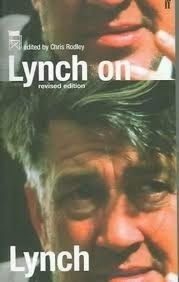
Inspired by the release on Blu-ray of "Twin Peaks" (and its follow-up prequel "Fire Walk With Me"), I pulled my copy of "Lynch on Lynch" off the shelf, eager to disappear down the strange, seductive maze of the mind of David Lynch.
Edited by Chris Rodley and last revised in 2007, the book is essentially a 300-page interview with Lynch, starting with his childhood and winding up, many chapters later, with talk of his 2001 masterpiece, "Mulholland Dr." In its pages, he discusses everything from his paintings to his rank as Eagle Scout to each one of his films. And, along the way, he describes many times in many different ways what make movies so strange and wonderful. Here's a quote from early in the book that should dissuade anyone from ever thinking they've "figured out" his movies:
"The neat thing about film is that it an tell a little bit of a certain side of the thing that words couldn't tell. But it won't tell the whole story, because there are so many clues and feelings in the world that it makes a mystery, and a mystery means there's a puzzle to be solved. Once you start thinking like that, you're hooked on finding a meaning, and there are many avenues in life where we're given little indications that the mystery can be solved. We get little proofs -- not the big proof -- but little proofs that keep us going. That there is a mystery is a HUGE THRILL." (emphasis his)
If you're not a fan of Lynch's unique brand of unsolvable puzzles, well, I can't convince you to feel otherwise -- because movies like "Blue Velvet" and "Eraserhead" and "Inland Empire" are something that, more than anything, you feel. But if you do like Lynch, and respond to the mysteries he creates, pick up this book. It's full of fascinating insights and Lynch's all-American good humor. His movies may be nightmarish, but he seems like a swell guy.
Published on August 11, 2014 16:13
August 5, 2014
Movies I Watched in July
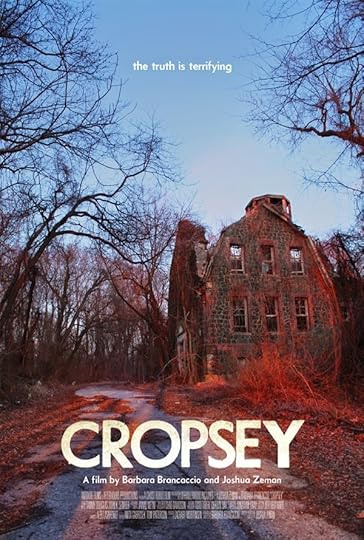 Intriguing little 2009 documentary (thank you, Netflix!) wherein filmmakers Joshua Zeman and Barbara Brancaccio trace the legend of a local boogeyman nicknamed “Cropsey” until it segues with the story of Andre Rand, a real-life man convicted of child abduction on Staten Island. Well filmed and nicely creepy, it reminded Amy and I of a really well done episode of “Dateline.” If you’re looking for an exciting solution to a complicated mystery you might be disappointed, but if you want nightmarish locations and unnerving memories, you’ve come to the right place.
Intriguing little 2009 documentary (thank you, Netflix!) wherein filmmakers Joshua Zeman and Barbara Brancaccio trace the legend of a local boogeyman nicknamed “Cropsey” until it segues with the story of Andre Rand, a real-life man convicted of child abduction on Staten Island. Well filmed and nicely creepy, it reminded Amy and I of a really well done episode of “Dateline.” If you’re looking for an exciting solution to a complicated mystery you might be disappointed, but if you want nightmarish locations and unnerving memories, you’ve come to the right place. An action movie with a premise so crazy – all of humanity lives in a giant train that circles the ice-covered Earth – and so simple – the lowest on the ladder move forward through the train to take control from the highest – it can’t help but work, and it does – gloriously, thrillingly and wonderfully strangely. There’s some imaginative production design (as we move forward through the train, the cars get more and more decadently nutty) and exciting fight scenes (an axe battle in the dark, with the badguys wearing night vision goggles? Yes, please!) but what really sets “Snowpiercer” apart is its invigorating sense of weirdness. That’s gotta be the influence of Korean director Bong Joon-Ho, who also brought us “Host” and “Memories of Murder.” The classroom scene, with a maniacal (and hugely pregnant) Alison Pill leading the kids is unforgettable, but even better are the small touches – my favorite is the aforementioned axe fighters dipping their blades into a fish before commencing to fight. What does it mean? I have no idea. Did I enjoy it? You bet your frozen ass I did.
An action movie with a premise so crazy – all of humanity lives in a giant train that circles the ice-covered Earth – and so simple – the lowest on the ladder move forward through the train to take control from the highest – it can’t help but work, and it does – gloriously, thrillingly and wonderfully strangely. There’s some imaginative production design (as we move forward through the train, the cars get more and more decadently nutty) and exciting fight scenes (an axe battle in the dark, with the badguys wearing night vision goggles? Yes, please!) but what really sets “Snowpiercer” apart is its invigorating sense of weirdness. That’s gotta be the influence of Korean director Bong Joon-Ho, who also brought us “Host” and “Memories of Murder.” The classroom scene, with a maniacal (and hugely pregnant) Alison Pill leading the kids is unforgettable, but even better are the small touches – my favorite is the aforementioned axe fighters dipping their blades into a fish before commencing to fight. What does it mean? I have no idea. Did I enjoy it? You bet your frozen ass I did.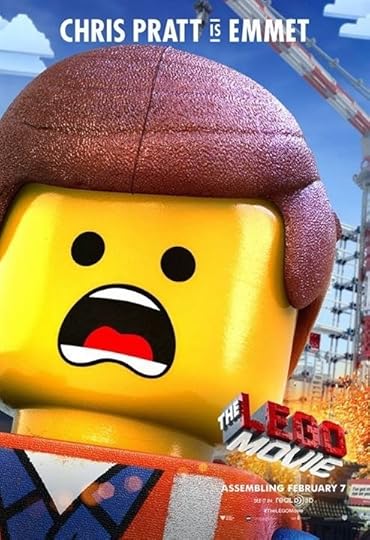 Allie got this one for her birthday, and I have to admit, I was as excited to watch it again as she was. It held up beautifully, frantic and crazy at the beginning but decidedly more sober and reflective toward the end. The scene where Emmett brings an end to Lord Business’ reign without a fight is a nice change of pace, and it’s one of two movies this year where Chris Pratt saves the day by holding someone’s hand. But I’ll talk about that in this space next month.
Allie got this one for her birthday, and I have to admit, I was as excited to watch it again as she was. It held up beautifully, frantic and crazy at the beginning but decidedly more sober and reflective toward the end. The scene where Emmett brings an end to Lord Business’ reign without a fight is a nice change of pace, and it’s one of two movies this year where Chris Pratt saves the day by holding someone’s hand. But I’ll talk about that in this space next month.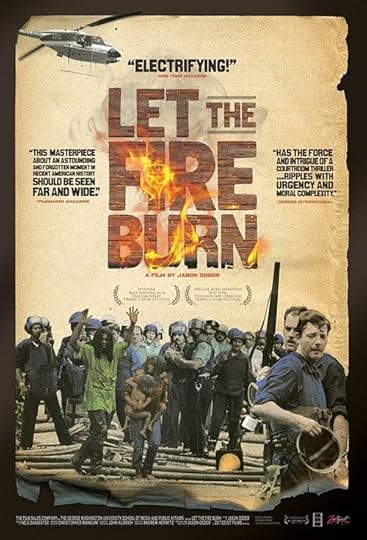 I vaguely remember hearing about MOVE, a radical (to put it mildly) black liberation organization that had its Philadelphia home (along with most of the homes nearby) firebombed by the police department back in 1978. This simple but effective documentary brings those frankly jaw-dropping events back into the spotlight, showing how things escalated so fast that no one had any idea (or, apparently, much desire) to de-escalate them. Told entirely through either testimony from a hearing not long after the event or news footage from the event itself, it’s compelling, depressing and, most of all, strange – it seems like the sort of thing that could only happen in the 1970s … and the sort of thing that seemed to happen over and over in the 1970s though, as you’ll see from “Let the Fire Burn,” it never happened quite like this. Fascinating stuff.
I vaguely remember hearing about MOVE, a radical (to put it mildly) black liberation organization that had its Philadelphia home (along with most of the homes nearby) firebombed by the police department back in 1978. This simple but effective documentary brings those frankly jaw-dropping events back into the spotlight, showing how things escalated so fast that no one had any idea (or, apparently, much desire) to de-escalate them. Told entirely through either testimony from a hearing not long after the event or news footage from the event itself, it’s compelling, depressing and, most of all, strange – it seems like the sort of thing that could only happen in the 1970s … and the sort of thing that seemed to happen over and over in the 1970s though, as you’ll see from “Let the Fire Burn,” it never happened quite like this. Fascinating stuff.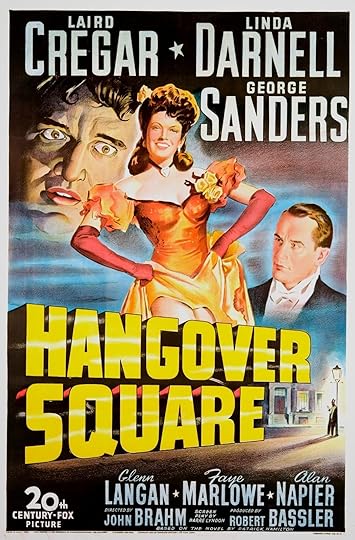 One of those (semi) horror movies that I’ve read a lot about but never actually got around to seeing – and I’m damned glad I did. Laird Cregar, a hulking sort of tragic hero, plays a composer who has the uneasy feeling that he’s been going on a murder rampage but hasn’t been able to remember it. (Spoiler alert for a 69-year-old film: He has.) Beautifully directed by John Brahm, it has some genuinely striking scenes and a great supporting performance by George Sanders playing a smooth-talking (of course) psychologist trying to get to the bottom of poor Laird’s troubles. The grand finale, where Laird performs his masterpiece on the piano as the entire theater burns down around him, is like nothing else I’ve ever seen – it must’ve been some sort of special effect, but it sure looks like it’s Laird himself there, surrounded (and almost engulfed) by deadly flames.
One of those (semi) horror movies that I’ve read a lot about but never actually got around to seeing – and I’m damned glad I did. Laird Cregar, a hulking sort of tragic hero, plays a composer who has the uneasy feeling that he’s been going on a murder rampage but hasn’t been able to remember it. (Spoiler alert for a 69-year-old film: He has.) Beautifully directed by John Brahm, it has some genuinely striking scenes and a great supporting performance by George Sanders playing a smooth-talking (of course) psychologist trying to get to the bottom of poor Laird’s troubles. The grand finale, where Laird performs his masterpiece on the piano as the entire theater burns down around him, is like nothing else I’ve ever seen – it must’ve been some sort of special effect, but it sure looks like it’s Laird himself there, surrounded (and almost engulfed) by deadly flames.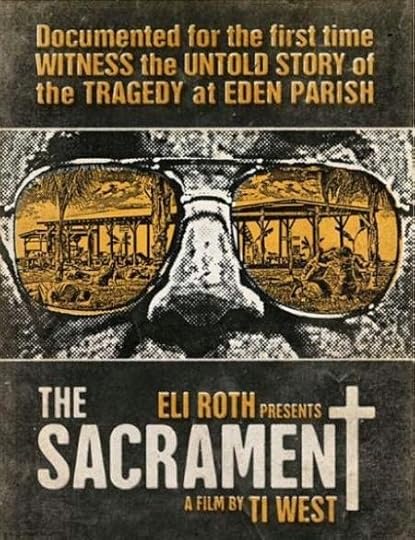 I was a huge fan of Ti West’s “House of the Devil,” a pitch-perfect recreation of early 1980s horror films, but I was a lot less thrilled by his follow-up, “The Innkeepers,” a slow slog of a ghost story. This one, a fake found footage re-imagining of the Jonestown story, falls somewhere in between the two. It’s never really very scary, but it is tense. We follow two guys as they track down a girlfriend who’s found a happy place in the religious retreat of “Eden Parish.” Naturally, things aren’t really that cheery, and though its spiritual leader, the Father, seems reasonable enough, he’s not about to let any outsiders convince any of his flock to stray back to civilization. If you know anything about the real Jonestown, you know what’s coming, and West follows it pretty much to the letter, with the only suspense coming from wondering whether our douchebag heroes will survive. Not bad, and Gene Jones (the store clerk from “No Country for Old Men” ) is truly mesmerizing as Father, but in the end you’d probably be better of just watching a documentary. (By the way, don't let that "Eli Roth presents" on the poster keep you away -- this movie is relatively bloodless.)
I was a huge fan of Ti West’s “House of the Devil,” a pitch-perfect recreation of early 1980s horror films, but I was a lot less thrilled by his follow-up, “The Innkeepers,” a slow slog of a ghost story. This one, a fake found footage re-imagining of the Jonestown story, falls somewhere in between the two. It’s never really very scary, but it is tense. We follow two guys as they track down a girlfriend who’s found a happy place in the religious retreat of “Eden Parish.” Naturally, things aren’t really that cheery, and though its spiritual leader, the Father, seems reasonable enough, he’s not about to let any outsiders convince any of his flock to stray back to civilization. If you know anything about the real Jonestown, you know what’s coming, and West follows it pretty much to the letter, with the only suspense coming from wondering whether our douchebag heroes will survive. Not bad, and Gene Jones (the store clerk from “No Country for Old Men” ) is truly mesmerizing as Father, but in the end you’d probably be better of just watching a documentary. (By the way, don't let that "Eli Roth presents" on the poster keep you away -- this movie is relatively bloodless.)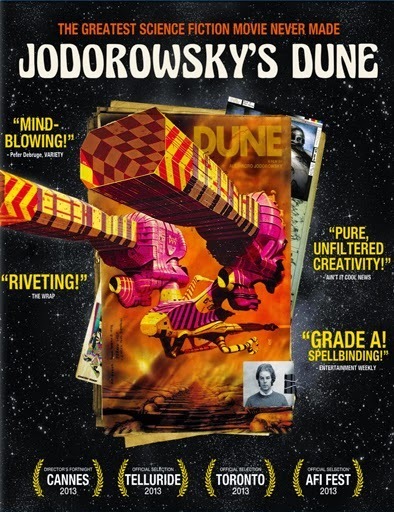 David Lynch’s version of “Dune” is pretty out-there, but it’s nothing compared to what would have resulted had the fates aligned and visionary (to put it mildly) director Alejandro Jodorowsky been able to bring his concept of the science fiction novel to the big screen. That never happened, alas, but this documentary is the next best thing, with Jodorowsky himself taking center stage to explain what he planned to do, whom he hired to help him and how it all fell apart at the end. Imagine a space epic starring (among others) Salvador Dali, Orson Welles and Mick Jagger, with storyboards by legendary cartoonist Moebius and concept drawings by legendary weirdo H.R. Giger, scored by Pink Floyd (among other bands) and featuring Jodorowsky’s son, who underwent a two-year, full-time intensive training. Yes, it’s a shame the film was never made, and the glimpses of the storyboards and concept drawings are beyond tantalizing, but Jodorowsky seems so happy just to tell the story that it’s hard to feel too bad about the whole thing. In fact, it’s hard to imagine how Jodorowsky’s “Dune” could be much more entertaining than “Jodorowsky’s Dune.”
David Lynch’s version of “Dune” is pretty out-there, but it’s nothing compared to what would have resulted had the fates aligned and visionary (to put it mildly) director Alejandro Jodorowsky been able to bring his concept of the science fiction novel to the big screen. That never happened, alas, but this documentary is the next best thing, with Jodorowsky himself taking center stage to explain what he planned to do, whom he hired to help him and how it all fell apart at the end. Imagine a space epic starring (among others) Salvador Dali, Orson Welles and Mick Jagger, with storyboards by legendary cartoonist Moebius and concept drawings by legendary weirdo H.R. Giger, scored by Pink Floyd (among other bands) and featuring Jodorowsky’s son, who underwent a two-year, full-time intensive training. Yes, it’s a shame the film was never made, and the glimpses of the storyboards and concept drawings are beyond tantalizing, but Jodorowsky seems so happy just to tell the story that it’s hard to feel too bad about the whole thing. In fact, it’s hard to imagine how Jodorowsky’s “Dune” could be much more entertaining than “Jodorowsky’s Dune.”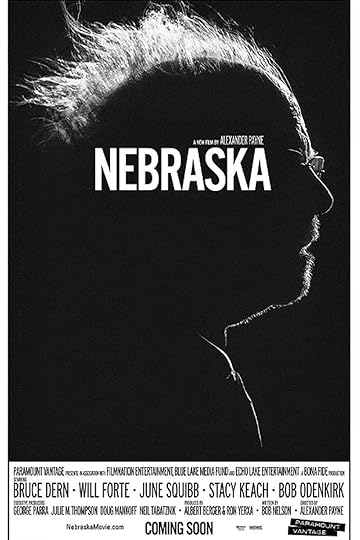 Slowly but surely Amy and I are working our way through the most acclaimed films of 2013, and we both enjoyed this one, a simple story about a dad (Bruce Dern) trying to walk from Montana to Nebraska to claim his (nonexistent) sweepstakes prize. Dern is truly great as the dad, and he gets surprisingly strong support from “Saturday Night Live” alum (and former MaCGruber) Will Forte. It’s a simple, slow (in the best sense) story, but director Alexander Payne keeps the focus on lives either stuck in neutral or wobbling toward the end. He gets a big assist from cinematographer Phedon Papamichael, who films the wide open wastelands of Nebraska in gorgeous black and white, lending a real sense of age and exhaustion to the surroundings. The whole cast is great, including Bob Odenkirk, Stacy Keach and Oscar nominee June Squib, but allow me to single out Angela McEwan, who has one scene (plus a silent shot at the end) that she really makes the most of, revealing a bit of Dern’s past and framing the entire story in a different – and surprising – light. “Nebraska” is a movie of small moments, and hers is one of the best.
Slowly but surely Amy and I are working our way through the most acclaimed films of 2013, and we both enjoyed this one, a simple story about a dad (Bruce Dern) trying to walk from Montana to Nebraska to claim his (nonexistent) sweepstakes prize. Dern is truly great as the dad, and he gets surprisingly strong support from “Saturday Night Live” alum (and former MaCGruber) Will Forte. It’s a simple, slow (in the best sense) story, but director Alexander Payne keeps the focus on lives either stuck in neutral or wobbling toward the end. He gets a big assist from cinematographer Phedon Papamichael, who films the wide open wastelands of Nebraska in gorgeous black and white, lending a real sense of age and exhaustion to the surroundings. The whole cast is great, including Bob Odenkirk, Stacy Keach and Oscar nominee June Squib, but allow me to single out Angela McEwan, who has one scene (plus a silent shot at the end) that she really makes the most of, revealing a bit of Dern’s past and framing the entire story in a different – and surprising – light. “Nebraska” is a movie of small moments, and hers is one of the best.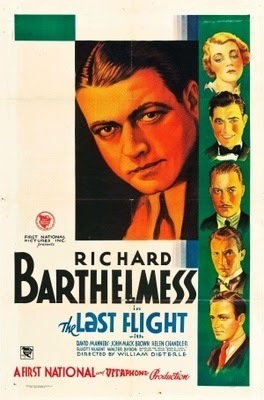 Such a strange little movie. Released in 1931, when memories of World War I was fairly fresh in the minds of the moviegoer, “The Last Flight” focuses on four American veterans who, for various war-related reasons, refuse to return to the states and instead spend their days getting drunk in Paris. Eventually, they run into Nikki, a similarly broken women with a similar fondness for alcohol, and they decide to invite her to be a part of their drunken little group. It’s not a great movie – Hollywood was still figuring out how to pace a sound movie in 1931, and some of the staging is going to look awfully awkward to modern eyes. But there’s something here, a real sense of desperation and defeat like I’ve seen in few movies, especially those made this long ago. The cast includes Richard Barthelmess, an actor who specialized in playing men who’d been broken (by war, society or fate) along with Helen Chandler and David Manners, who both starred in “Dracula” that same year. The next time it shows up on TCM (where else?), give it a look. It’s well worth the 80 or so minutes it’ll take to watch.
Such a strange little movie. Released in 1931, when memories of World War I was fairly fresh in the minds of the moviegoer, “The Last Flight” focuses on four American veterans who, for various war-related reasons, refuse to return to the states and instead spend their days getting drunk in Paris. Eventually, they run into Nikki, a similarly broken women with a similar fondness for alcohol, and they decide to invite her to be a part of their drunken little group. It’s not a great movie – Hollywood was still figuring out how to pace a sound movie in 1931, and some of the staging is going to look awfully awkward to modern eyes. But there’s something here, a real sense of desperation and defeat like I’ve seen in few movies, especially those made this long ago. The cast includes Richard Barthelmess, an actor who specialized in playing men who’d been broken (by war, society or fate) along with Helen Chandler and David Manners, who both starred in “Dracula” that same year. The next time it shows up on TCM (where else?), give it a look. It’s well worth the 80 or so minutes it’ll take to watch.
Published on August 05, 2014 19:33
July 25, 2014
Words on Film, Part 8: 'Writing Movies for Fun and Profit'
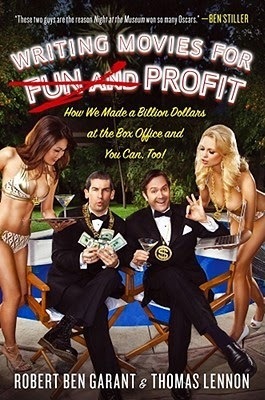
There are a ton of books out there promising you the secrets to screenplay success, and as a guy who writes comic book scripts (which, if you squint just right, look sort of like movie scripts), I've read just about all of them. Everything from Robert McKee's "Story" to Syd Fields' endless analyses of the three-act structure to "Save the Cat," a book from the guy who wrote (wait for it) "Stop! Or My Mom Will Shoot." But I don't think I've ever read one as coldly realistic and downright practical as "Writing Movies for Fun and Profit" by Robert Ben Garant and Thomas Lennon.
In case you don't know, these guys are responsible for the screenplays (or at least some of the many, many drafts of the screenplays) of "Night at the Museum," "Herbie: Fully Loaded" and "The Pacifier." Are these movies good? Nope. Did they get produced? Yep. Did they turn a profit? You bet your ass they did. And in clear, step-by-step chapters, Garant and Lennon tell you exactly how to write a screenplay that will (a) get bought (b) get made and (c) find an audience.
They stress they're not talking about groundbreaking indie films or personal artistic tales. The book's title has "Fun and" crossed out for a reason. It's not a guide about bringing your vision to the screen. Studios want a certain thing that (they think) audiences want, and though it might not stretch your artistic muscles (or it might stretch them in the wrong direction), Garant and Lennon tell you how to give the studios exactly what they're in the market for. Basic character beats, crowd-pleasing jokes, obvious emotional arcs -- they're all here, and they can all be broken down into simple, step-by-step instructions. And frankly, much of this advice applies even if you are trying to tell a personal story, on the screen or (in my case) on the page. Strong structure is never a bad thing, and if you can write a comic book anywhere nearly as compelling and satisfying as, say, "Die Hard," (which they rightly cite as one of the best Hollywood movies ever made) then, my friend, you are onto something.
It helps that Garant and Lennon are also a couple of very, very funny guys. In addition to all those bland Hollywood comedies on their resumes, they're also two of the minds behind "The State" and "Reno 911," which are absolutely not mainstream comedies and, unlike say, "Herbie: Fully Loaded," something any writer would be proud to have created. And they bring that off-kilter humor into every page of the book, delivering genuinely solid and practical advice with wit and imagination. Sprinkled among the chapters are sample movie pitches that you're free to use (really!) along with an extensive glossary of all the terms you see in the end credits and, in case you movie to Los Angeles (and, if you plan to write movies, they stress you really REALLY should), a complete list of all In And Out Burger locations.
What more do you want in a screenwriting guide? More babbling on about Aristotle? Please. Buy this book and move to L.A. Hell, it's what I should be doing.
Published on July 25, 2014 21:08
July 15, 2014
Buy My Comics, Make Me Rich: TEEN TITANS #1
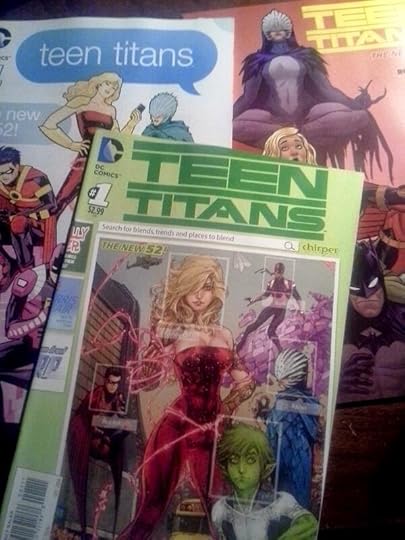
That's right, TEEN TITANS #1, with script by yours truly, jaw-dropping art by Kenneth Rocafort, colors by Dan Brown and letters by John J. Hill, hits the stores tomorrow. I promise you it includes plenty of action and adventure (there's a busload of terrorists and schoolgirls speeding through the streets of New York), some humor and more than a few surprises.
While you're at it, why not pick up three copies of the issue? Kenneth, Cliff Chiang (my CRISIS AFTERMATH: THE SPECTRE collaborator and Joe Quinones each did a cover, and they're all beauties.
And if you want a preview of what's inside, click here.
Published on July 15, 2014 18:55
July 11, 2014
Words on Film, Part 7: 'Shock Value'
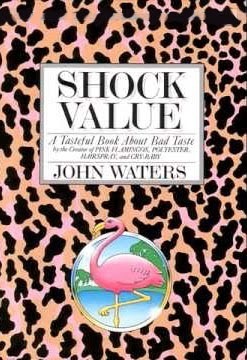
When I was a freshman at Kent State, way back in the fall of 1985, cult film director John Waters visited our campus as part of the Filmworks program. One night, they showed "Pink Flamingos" (and if you've never seen "Pink Flamingos," take it from me -- freshman year is the perfect time to experience that particular cinematic endurance test), then the next night, Waters himself introduced "Polyester," answered some questions and signed autographs. I got my "Polyester" Odorama scratch-and-sniff card signed (it still hangs above my desk almost 30 years later), but after hearing Waters' hilarious tales of filmmaking and fringe culture, what I really wanted him to do was write a book collecting all those stories. Imagine my surprise when a girl in line in front of me handed him a copy of "Shock Value" to sign.
The next day, I was at the campus bookstore, ordering a copy of my very own. (No Amazon.com back in those days, kids.) I devoured the book as soon as it arrived a week or so later, and was happy to discover it was just as funny as hearing him in person. I've always been a fan of Waters' films (especially "Female Trouble," his funnier follow up to "Pink Flamingos), but I honestly think his best work is his writing. "Shock Value," which is his first book, acts as both a hilarious autobiography and revealing look at the offbeat pleasures of cult films. Besides the chapters on his childhood, his love of Baltimore and the making of his movies, Waters also devotes pages to his cinematic heroes, Russ Meyer and Herschell Gordon Lewis. I'm pretty sure it was "Shock Value" that introduced me to Meyer's ode to violence, "Faster, Pussycat! Kill! Kill!," and for that alone, it has my eternal gratitude.
Between reading Waters' book, Michael Weldon's "Psychotronic Encyclopedia of Film" and Danny Peary's "Cult Movies," my film horizons expanded greatly during my first year of college. "Shock Value" is, for obvious reasons, the most narrowly focused of those books, but it's also (for more obvious reasons) the funniest and the most personal. Waters' movies are frequently horrifying and often disturbing (especially his early ones), but if you read "Shock Value," you come to realize that, transgressive or not, he's really a pretty nice guy.
Published on July 11, 2014 20:48
July 4, 2014
Movies I Watched in June
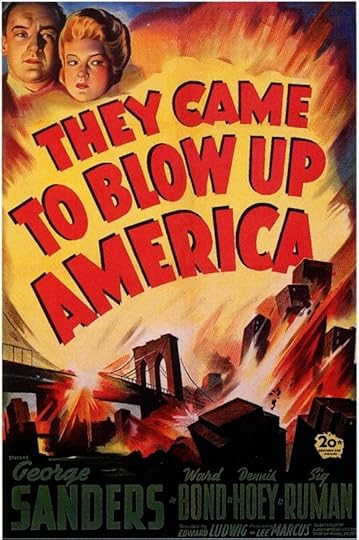
Great title, so so movie. George Sanders plays a smooth-talking (of course), duplicitous (of course) double agent who's plotting destruction of this great land of ours during World War II -- or is he? Ward Bond co-stars, because he's in every movie of this era. Sanders is great, as he is in all of his movies, from "All About Eve" to "The Jungle Book," but this one never reaches the thrilling heights of anti-Nazi mania of something like "Confessions of a Nazi Spy." And, like "Tear Gas Squad" from last month's roundup, the poster depicts a scene roughly a thousand times more exciting than anything actually in the movie.
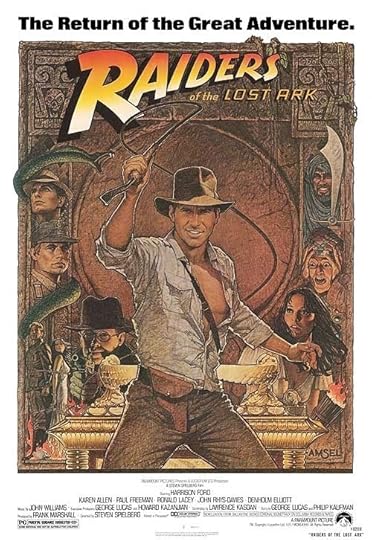
It still holds up. What's more, it looks positively low-key and stately in the modern movie era, which is something I probably said the last time I wrote this movie up, but don't have the time nor energy to check right now. I will say this: The scene where Jones and Marcus explain the Ark of the Covenant to the two government guys (one of them played by Lt. Porkins from "Star Wars") is a model of concise, compelling exposition. It tells us what we need to know to understand (and enjoy) the rest of the movie (hell, it practically lays out the entire structure of the film) but it also builds up an ominous sense of suspense, suggesting that we're about to see something really amazing -- and possibly terrifying. All the elements -- the setting, the props (that giant, ancient book), the dialogue, the performances and especially John Williams' score -- all come together to prepare us for a real adventure.
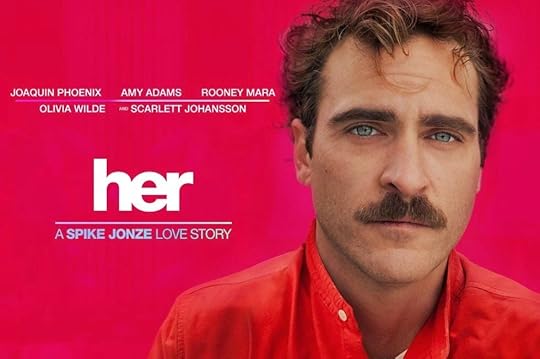
Though it skirts the edge of twee-ness, this romance about a man and his operating system is the sort of smart, thoughtful film you hope you'll see when the name "Spike Jonze" is in the credits. Dialing the intensity waaaaaay back from his stunning performance in "The Master," Joaquin Phoenix brings a low-key likability to his role, and if you're going to cast a voice that's going to convince a guy to start a relationship with this computer, Scarlett Johansson is a pretty tough choice to top. Best of all, "Her" has one of the most convincing and well thought-out depictions of a near future I've ever seen, with just a few small touches -- what's with those high-waisted pants? -- to let you know you're not in the present. Plus, the damn thing just looks spectacular. High pants or not, I want to work in that office building.
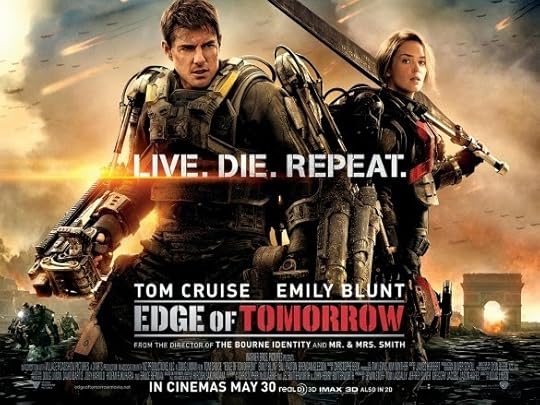
Different sort of science fiction film, but in its own way it's just as smart as "Her" with a male-female relationship at its center that's just as intriguing. Tom Cruise plays a fast-talking P.R. guy whose big mouth and obvious cowardice lands him a spot on the front row of a D-Day-like last stand against alien invaders. When he dies in battle right after landing, he wakes up back before the battle, and finds himself reliving the same deadly day over and over and over... Yes, it's "Groundhog Day," but even more to the point, "Edge of Tomorrow" is a real video game movie, one that takes the essential structure (fight, die, reset, fight, get a little further, die, reset, repeat, repeat, repeat) and grafts it onto a compelling story. It's full of surprises, the best being the character played by Emily Blunt, a war hero nicknamed alternately "The Angel of Verdun" and "Full Metal Bitch." She's held up by military p.r. (in other words, Cruise) as someone who learned how to use her high-tech combat suit in a single day and fought the aliens to a standstill, but midway through the movie you realize she had the same experience as Cruise and, like him, she spent a long time living that day over and over, getting better and better each time. This one is, for some reason, having trouble at the box office, probably because your average movie-going moron prefers dreck like "Transformers" and "Tammy." If it's playing in your town, check out "Edge of Tomorrow." You'll be glad you did.
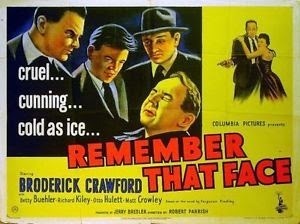
Pretty solid crime drama (I saw it on TCM under the title "The Mob") about a detective (Broderick Crawford) who fakes suspension from the force to go undercover and infiltrate the waterfront syndicate. Broderick's good, obnoxiously throwing his weight around as usual, and watch for brief appearances by Ernest Borgnine and Charles Bronson. There's also an amusing bit near the end when the cops attach a tank of luminescent paint that drips behind the badguys' car, and they act like it's the pinnacle of high technology. Ah, 1951.
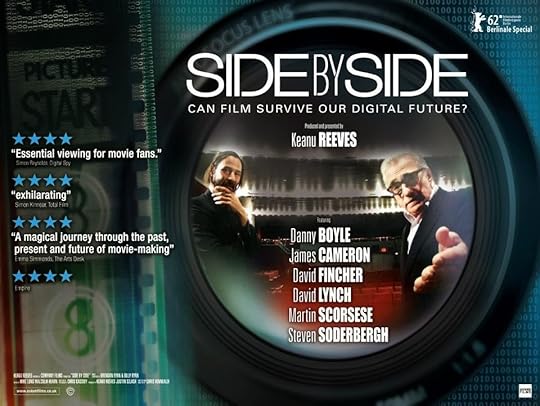
Keanu Reeves hosts this easy-going documentary showcasing the rise of digital filmmaking and the (possible) death of actual celluloid. Being a big star (and, to give him credit, a solid host), Reeves is able to get some big names to talk about the issue, including Scorsese, Lynch, Cameron, Soderbergh, Fincher and others. Most of them have accepted digital filmmaking and tout its benefits, with just about the only guy remaining devoted to actual film being Christopher Nolan. Beyond the film/digital debate, "Side By Side" also offers a brief history of various film formats and, on the whole, is a pretty thoughtful look at how movies are made and why they're made that way. Christopher Kenneally, by the way, is the man who wrote and directed this movie. I figured with all the attention being paid to Keanu, I should mention that somewhere.
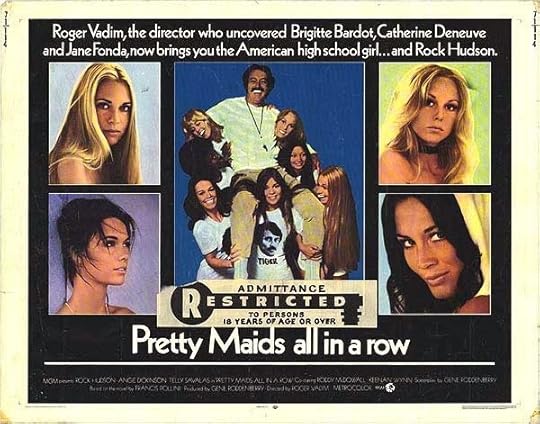
Once again, it always amazes me what sort of movie Turner Classics will show late at night. This 1971 oddity features, among other things, Rock Hudson as a football coach/teacher who both sleeps with most of the (female) student body while simultaneously encouraging substitute teacher Angie Dickinson to take the virginity of his nerdish equipment manager (John David Carson, playing a student named, believe it or not "Ponce de Leon Harper). As if that weren't strange enough, when the dead bodies of those girls start turning up, Telly Savalas shows up to investigate, playing a very Kojak-like cop about two years before "Kojak" went on the air. He's assisted by James "Scotty" Doohan, which makes sense when you realize that "Star Trek" creator Gene Roddenberry is the guy who wrote this sexed-up serial killer comedy, and Roger Vadim directs the whole thing with an endlessly leering eye to all the young high school girls. I can honestly say I've never seen anything quite like it. Oh, and spoiler alert, the killer gets away with it in the end, and the most down-to-earth character in the movie seems all set to follow in his footsteps. Enjoy!
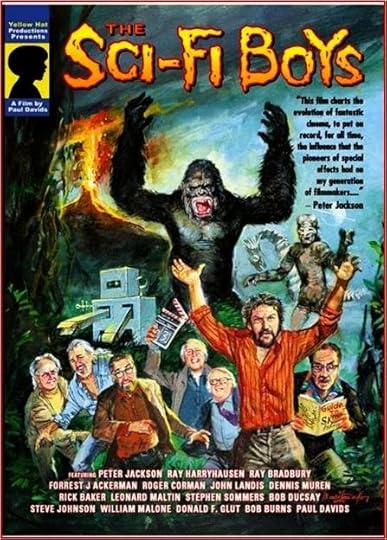
Scattershot documentary tracing the rise of horror movie culture through (mostly) the pages of the legendary magazine "Famous Monsters of Filmland," with frequent side trips to Ray Harryhausen getting a star on the Walk of Fame or John Landis (always entertaining) talking about exploitation films. It's a lot of fun, and if you're not familiar with this subculture (I, ahem, obviously am), you'll learn a lot about how a magazine for little boys shaped a lot of the pop culture you ingest today.
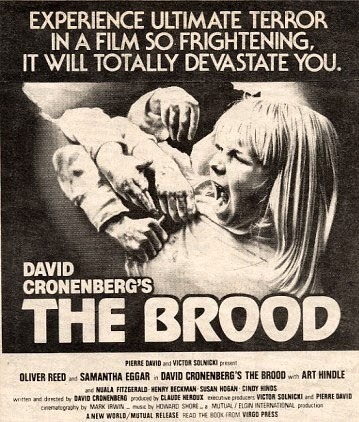
Filling in the gaps on my "David Cronenberg Movies I've Seen" list, I watched this 1979 chiller late one night, after everyone else had gone to bed -- which seems like the perfect time to watch "The Brood." Though it's definitely a movie I wish I hadn't read about before seeing (I knew the basic plot and the big shock scene at the end), it still packs a punch, offering up the usual Cronenberg combination of a smart screenplay, some genuinely intriguing concepts, a chilly atmosphere and, of course, gut-wrenching gore. I won't spoil anything here for you (RAGE BABIES!) but here's something to know going in: When he was making "The Brood," which is a movie about a couple fighting a bitter custody battle while the wife is separated from the rest of the family in a cultish group, Cronenberg was apparently fighting a bitter custody battle while his wife was separated from the rest of the family in a cultish group. Once you do watch "The Brood," you'll see how that bit of real-life background makes everything even more disturbing. In other words, highly recommended.
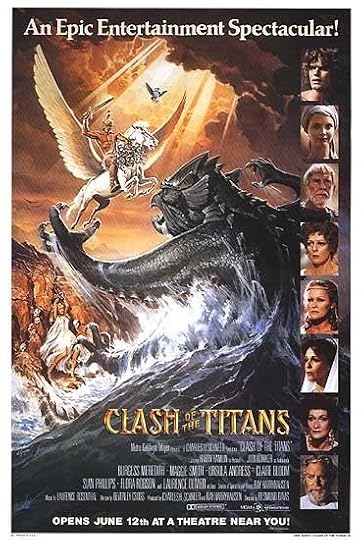
Allie's been into Greek myths lately, so we decided to show her this 1981 smorgasbord of legends and lore, featuring a slew of distinguished actors and some stellar effects work by the aforementioned Ray Harryhausen. I saw this in the theater way back when and liked it so much a friend got me the Alan Dean Foster novelization for my birthday. I'm happy to say it still holds up nicely. Sure, some of the stop-motion effects look a little bit dated, but they're wonderfully, beautifully dated, still showing off the painstaking craft that went into them decades later. (Compare that to dated CGI, which just looks awful.) And, when we get to the thrilling climax where Perseus (Harry Hamlin) has to fight the (stop-motion) Medusa, all the elements come together to deliver a scene that still looks spectacular and generates a real sense of menace and dread. Plus, like many movies of the early 1980s aimed at young teen boys, there are two scenes of obviously needless nudity included just to add a bit of prurient interest. My 13-year-old self says thank you!
Published on July 04, 2014 06:17
Will Pfeifer's Blog
- Will Pfeifer's profile
- 23 followers
Will Pfeifer isn't a Goodreads Author
(yet),
but they
do have a blog,
so here are some recent posts imported from
their feed.



